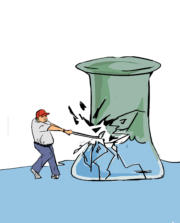
*Names have been changed to protect source privacy.
An important aspect of the Humanizing Aragon campaign is spreading awareness about and understanding people with differing abilities. When addressing this in an academic context, Aragon strives to support students of all learning capacities through its special education classes, Directed Studies classes and the district’s Bridging Adults in Youth Academy, among other strategies.
PROGRAM
Special education at Aragon and the San Mateo Union High School District consists of a variety of different services depending on the student’s Individualized Education Plan, a legal document drawn up by the stakeholders that determines how to support students with disabilities in their learning. The district offers Directed Studies, which is a homework support class for all students, co-taught classes that include both a general and special education teacher, and separate services such as speech language therapy and psychology. Specialists also personally assist students who take general education classes or prepare students for their post-high school paths through a Career Awareness program.
Junior *Carter uses speech therapy and takes Directed Studies to fulfill his IEP.
“Whenever I struggle, [my] teachers give me so much help,” Carter said. “My English teacher does a really good job. She gives a lot of detail on the subjects we talk about; currently, we’re learning about the Odyssey … With [the] help I’m getting, I have a great career ahead of me … Everything about [having] an IEP at Aragon is pretty good. I don’t find any major issues whatsoever.”
Although Aragon shares all of the District’s special education services, it also features academic classes co-taught by a special education teacher and a general education teacher, which no other school in the District provides.
Giancarlo Corti teaches two sections of Government and Economics, one of which is a co-taught class.
“The extra resource of another teacher makes it so that it’s really easy to meet the needs of all the students individually,” Corti said. “I’m sure there [are] situations where the needs of students with IEPs might be higher than what two teachers can manage while still trying to get through [the] curriculum for everyone else in the class. But that is not my experience. My experience, at least with teaching Government Economics, has been [that] we can do both those things at the same time.”
The San Mateo Union High School District special education system is considered to be largely successful.
“We have one of the best special education programs that I have had an opportunity to work with, and I’ve been doing this for quite some time,” said director of Special Education services Rochelle Hooks. “All of the teachers do a really excellent job. I appreciate how they go above and beyond to support families … One of the differences [between our district and others] is that a lot of case managers are working with general [education] teachers significantly more than I’m used to seeing previously, and that’s really key … Where a lot of districts sometimes keep students separate, we do a really good job at integrating them into general education. When you’re in general education, that’s where you’re getting the first and best instruction with teachers who are credentialed in that subject.”
The District also aims to help students in special education classes in many of the same pursuits as general education students as best they can.
“The main hope is that they are successful in however they identify success and do the things that they want to do,” Hooks said. “It can look like going to community college or a four-year college. It could look like going to the military or vocational school or jumping right into the job market. For our students who are more severely impacted by their disability, sometimes it’s an adult day program or supported employment or supported housing.”
STUDENT AWARENESS
One group that aims to create greater awareness and support for students receiving special education services is Aragon’s Best Buddies Club. This club works as a space where students in general and special education can spend time together and spread positivity on campus. When the BAY Academy, a program for students with moderate to severe disabilities, was at Aragon from 2022-24, members of the club were able to form connections with those with the BAY Academy program.
At a young age, junior Best Buddies Club treasurer Samantha Stanley observed a lot of the struggles that students in special education face.
“Back from elementary school, when I was in the same classroom [with students with special needs], there wasn’t really a special [education] department, [as] they were in [general education] classrooms,” Stanley said. “And there was never really any support for them. They would have an aide, but it was an adult, and it was definitely more isolating. I had a friend and she was special needs, and I didn’t even register [that] in my brain, I [just] knew she looked different from other people. She had Down Syndrome, but she was just a normal person and people never really saw her that way. She was in my classes and we would have normal conversations and people would be like, ‘oh, isn’t she weird? She acts differently.’ I was like ‘not really, she’s just a normal person.’ So [that experience] built empathy [and] got me into advocating for basic human rights or treatment.”
Despite this mentality that Stanley has seen in elementary school, Carter has not personally experienced it at Aragon.
“Students with IEPs like me are treated well,” Carter said. “Other students treat [us] pretty fairly. There hasn’t been any bullying or stigma in any way.”
Though students may not be overtly rude, some believe there remains a barrier at Aragon between students that further isolates students with special needs.
“It never felt like blatant disrespect, like mean bullying or anything, but [people would talk] behind their back, or maybe just a snide comment that you wouldn’t say to a ‘normal’ person,” Stanley said. “A lot of people don’t [appreciate their] personalities. A lot of people just put them in a box and don’t go out of their way to interact with them. Even just saying ‘them,’ like ‘them and us,’ is very rooted in our everyday life … If you just sit down and have a conversation at our club, they’re just people, and it’s super fun, just like having a conversation with anyone else.”
Junior Best Buddies Club president Victoria Chen similarly believes students must change their mindset to allow for more unity on campus.
“It’s the same thing as someone who doesn’t have a disability,” Chen said. “You can still be friends and you can do everything … People being more open to different people [helps]. Going out of your way to include someone that you might have not originally may be out of your comfort zone, but you should still do it.”
This idea of inclusivity falls in line with the Humanizing Aragon campaign.
“In [terms] of the humanizing language and humanizing, it’s more an inclusive practice in being empathetic to potentially how others are impacted,” Hooks said. “And considering that, you’d want to think, ‘how am I including students with disabilities?’”

LARGER IMPACTS
On a broader scale, these special education systems have been proven to be successful at helping students with special needs graduate, especially in comparison to statistics statewide.
According to the Western Association of Schools and Colleges report, 94.3% of Aragon students with disabilities graduated in the 2022-23 school year, compared to 86.4% of California students that same year, as indicated in the California School Dashboard. Nationally, the graduation rate for students with disabilities is 74%, from the 2021-22 school year.
However, special education has been a point of contention within the Trump administration’s newest decisions.
On March 20, President Donald Trump signed an executive order mandating the shutdown of the Department of Education. The department administered the Individuals with Disabilities in Education Act, which provided public and special education services to students with disabilities and grants nationwide. The following day, Trump announced that special education would be moved to the Department of Health and Human Services. It is unclear whether special education employees from the Department of Education will work on special education at the HHS or employees from the HHS will be involved.
With the fate of federal special education up in the air, states might play a larger role in the administration of special education.
“If the state laws were what started governing special education in California, I have a lot of faith that … California as a state would be very good at meeting that need [for special education],” said Aragon Psychologist Gina Sunie-Lopez. “My hope is that that doesn’t go anywhere from the federal law, and we don’t stop getting support from the federal government because it’s necessary to keep these programs going.”
Some students strongly oppose the idea of removing funding for these programs.
“That sounds like a stupid idea,” Carter said. “It’s pathetic how … the Trump administration thinks that disorders like autism [are] a disease when it is not.”
However, even if national funding is slashed, some believe that it may have a smaller impact than expected.
“The federal government has not paid their fair share [of funding for special education] for years,” said Special Education teacher Michael Gibbons. “If they totally stop funding, then the District has a lot of money, they’ll have to decide how to spend it and special education services are a legal [state] mandate.”
While the effects of the Trump administration’s actions on special education at Aragon remain unknown, its special education department will continue striving to provide quality education for students with disabilities.




